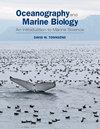ECOLOGY OF COLD SEEP SEDIMENTS: INTERACTIONS OF FAUNA WITH FLOW, CHEMISTRY AND MICROBES
1区 生物学
Q1 Agricultural and Biological Sciences
引用次数: 574
Abstract
Cold seeps occur in geologically active and passive continental margins, where pore waters enriched in methane are forced upward through the sediments by pressure gradients. The advective supply of methane leads to dense microbial communities with high metabolic rates. Anaerobic methane oxidation presumably coupled to sulphate reduction facilitates formation of carbonates and, in many places, generates extremely high concentrations of hydrogen sulphide in pore waters. Increased food supply, availability of hard substratum and high concentrations of methane and sulphide supplied to free-living and symbiotic bacteria provide the basis for the complex ecosystems found at these sites. This review examines the structures of animal communities in seep sediments and how they are shaped by hydrologic, geochemical and microbial processes. The full size range of biota is addressed but emphasis is on the mid-size sediment-dwelling infauna (foraminiferans, metazoan meiofauna and macrofauna), which have received less attention than megafauna or microbes. Megafaunal biomass at seeps, which far exceeds that of surrounding non-seep sediments, is dominated by bivalves (mytilids, vesicomyids, lucinids and thyasirids) and vestimentiferan tube worms, with pogonophorans, cladorhizid sponges, gastropods and shrimp sometimes abundant. In contrast, seep sediments at shelf and upper slope depths have infaunal densities that often differ very little from those in ambient sediments. At greater depths, seep infauna exhibit enhanced densities, modified composition and reduced diversity relative to background sediments. Dorvilleid, hesionid and ampharetid polychaetes, nematodes, and calcareous foraminiferans are dominant. There is extensive spatial heterogeneity of microbes and higher organisms at seeps. Specialized infaunal communities are associated with different seep habitats (microbial mats, clam beds, mussel beds and tube worms aggregations) and with different vertical zones in the sediment. Whereas fluid flow and associated porewater properties, in particular sulphide concentration, appear to regulate the distribution, physiological adaptations and sometimes behaviour of many seep biota, sometimes the reverse is true. Animal-microbe interactions at seeps are complex and involve symbioses, heterotrophic nutrition, geochemical feedbacks and habitat structure. Nutrition of seep fauna varies, with thiotrophic and methanotrophic symbiotic bacteria fueling most of the megafaunal forms but macrofauna and most meiofauna are mainly heterotrophic. Macrofaunal food sources are largely photosynthesis-based at shallower seeps but reflect carbon fixation by chemosynthesis and considerable incorporation of methane-derived C at deeper seeps. Export of seep carbon appears to be highly localized based on limited studies in the Gulf of Mexico. Seep ecosystems remain one of the ocean's true frontiers. Seep sediments represent some of the most extreme marine conditions and offer unbounded opportunities for discovery in the realms of animal-microbe-geochemical interactions, physiology, trophic ecology, biogeography, system-atics and evolution.冷渗沉积物的生态学:动物与水流、化学和微生物的相互作用
冷渗漏发生在地质活跃和被动的大陆边缘,富含甲烷的孔隙水在压力梯度的作用下向上穿过沉积物。甲烷的平流供应导致微生物群落密集,代谢率高。厌氧甲烷氧化可能与硫酸盐还原相结合,促进了碳酸盐的形成,并且在许多地方,在孔隙水中产生极高浓度的硫化氢。食物供应的增加,硬基质的可用性以及提供给自由生活和共生细菌的高浓度甲烷和硫化物,为这些地点发现的复杂生态系统提供了基础。本文综述了渗漏沉积物中动物群落的结构及其受水文、地球化学和微生物作用的影响。讨论了生物群的全尺寸范围,但重点是中型沉积物栖息动物(有孔虫、后生动物、小型动物和大型动物),这些动物受到的关注比巨型动物或微生物少。渗漏处的巨型动物生物量远远超过周围的非渗漏沉积物,主要是双壳类动物(足壳类、囊壳类、lucinids和thyasiids)和维氏管虫,有时也有足虫、枝状海绵动物、腹足类和虾。相比之下,陆架和上斜坡深度的渗漏沉积物的动物密度通常与环境沉积物的动物密度相差很小。在更深的深度,相对于背景沉积物,动物渗漏表现出密度增加、组成改变和多样性减少。雌雄多毛纲、雌雄多毛纲、线虫和钙质有孔虫占主导地位。渗漏区微生物和高等生物具有广泛的空间异质性。特殊的动物群落与不同的渗漏栖息地(微生物垫、蛤床、贻贝床和管虫聚集)和沉积物中不同的垂直带有关。流体流动和相关的孔隙水性质,特别是硫化物浓度,似乎调节着许多渗透生物群的分布、生理适应和有时的行为,但有时情况恰恰相反。动物与微生物在渗漏处的相互作用是复杂的,涉及共生、异养营养、地球化学反馈和栖息地结构。渗漏动物的营养成分各不相同,以硫营养型和甲烷营养型共生细菌为大多数巨型动物提供营养,而大型动物和大多数小型动物主要是异养的。大型动物的食物来源主要以浅层渗漏的光合作用为基础,但反映了在深层渗漏中通过化学合成和大量甲烷衍生碳的结合进行的碳固定。根据在墨西哥湾进行的有限研究,渗碳的出口似乎高度本地化。渗漏生态系统仍然是海洋真正的前沿之一。渗漏沉积物代表了一些最极端的海洋条件,并为动物-微生物-地球化学相互作用、生理学、营养生态学、生物地理学、系统学和进化等领域的发现提供了无限的机会。
本文章由计算机程序翻译,如有差异,请以英文原文为准。
求助全文
约1分钟内获得全文
求助全文
来源期刊
自引率
0.00%
发文量
0
期刊介绍:
With increasing interest in the field and its relevance in global environmental issues, Oceanography and Marine Biology: An Annual Review provides authoritative reviews that summarize results of recent research in basic areas of marine research, exploring topics of special and topical importance while adding to new areas as they arise

 求助内容:
求助内容: 应助结果提醒方式:
应助结果提醒方式:


